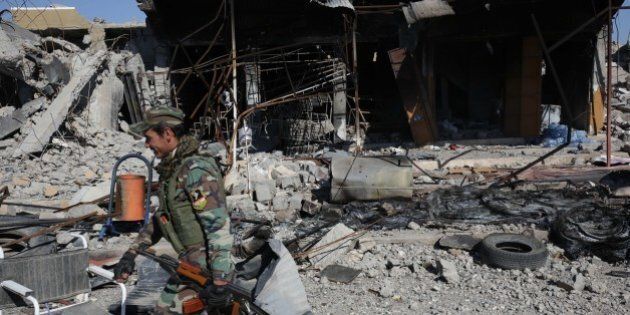
Over the past month, ISIS appears to have adopted a radically new strategy.
On Saturday 9 October, two militants carried out a suicide attack near Ankara's main train station, killing 97 people and wounding 250 others.
Then, on Saturday 31 October, a Russian passenger plane travelling from a holiday resort on the Red Sea to St. Petersburg was downed, killing all 224 passengers and crew.
On Thursday 12 November, three militants killed 43 civilians using suicide vests in a mainly Shia southern suburb in Beirut, a Hezbollah stronghold.
Now, on Friday 13 November, seven militants killed 132 and wounded another 352 - of whom 99 remain in a serious condition, at multiple locations around central Paris.
ISIS has claimed responsibility for all of these acts. If that is true, and these acts were planned and coordinated by ISIS central, then this marks a significant shift in the strategy employed by ISIS to date.
Up until recently, ISIS has concentrated only on carving out a caliphate in the Middle East. ISIS central encouraged overseas supporters to either travel to the Middle East to take part in the war, or if they were unable to do that, then to mount their own independent "lone wolf" attacks at home. No training, resources, operational assistance or otherwise were provided by ISIS central to these lone wolves. As such, these lone wolf attacks had little or no planning and used easily accessible weapons, such as single shot rifles, knives and even bricks.
The Lindt Café siege in Sydney and the shooting of Curtis Cheng in Parramatta earlier this year are typical of these lone wolf attacks.
Why the change in strategy?
As I wrote in The Huffington Post Australia earlier in the year, US Chairman of the Joint Chiefs of Staff, Martin Dempsey, had called the fight against ISIS a "tactical stalemate" and he saw no "dramatic gains on either side." However, recently, this has been to slowly change, with the battlefield momentum beginning to turn against ISIS.
In the last week, the Syrian Army loyal to president Bashir al-Assad, with the support of Russian strike fighters and helicopter gunships, ended the ISIS siege of the airfield at Kweiris, west of Aleppo. This is Damascus's biggest victory against ISIS in over two years.
In the last couple of weeks, the Kurdish forces have also made significant gains against ISIS. The Syrian Kurds, with US air support, have made territorial gains around Hasaka, while the Iraqi Kurds have captured Sinjar City near Mosul.
Sinjar is a particularly costly loss for ISIS as it will now find it increasingly difficult to move its forces between Raqqa and Mosul, and the ISIS held oilfields in northeast Syria are at risk of being captured by the Kurdish forces.
The involvement of foreign forces in the fight against ISIS is swinging the battlefield momentum in favour of the Syrian and Kurdish forces.
ISIS central appears to be redirecting its finite military capabilities so as to apply pressure on foreign interveners by attacking its civilians on its own soil. The hope is that these attacks will compel Turkey, Lebanon, Russia and France to withdraw its forces from the fight against ISIS.
It is a risky strategy.
On the one hand, there are rare and particular examples of this strategy having been successful. The Madrid Bombings (2004) appear to have influenced the Spanish elections sufficiently enough to install a Socialist Government. The Socialists had previously promised to withdraw Spain's troops from Iraq, which they promptly did on gaining government.
But, on the whole, when confronted by terror tactics, foreign governments have historically been more likely to double-down rather than withdraw. For example, in 2002, 40 Chechen rebels took 850 hostages at a Moscow theatre. The Russian forces used gas to end the siege that left 170 people dead, including all 40 terrorists. Moscow subsequently tightened its grip on Chechnya; President Putin's response was the complete opposite to what the Chechen rebels had intended. Similarly, following the September 11 attacks, America did not withdraw its forces from the Middle East, but instead invaded Afghanistan and later Iraq.
Over the short term, as ISIS military power continues to be worn down, its central leadership is likely to redirect a greater proportion of its resources towards international terrorist operations, as we have seen in the last month or so. So, worryingly, the current string of attacks may continue. Its modus operandi is likely to evolve to resemble the style of coordinated attacks we have come to expect from al-Qaeda.
We must keep in mind, however, that this change in strategy is being driven by ISIS central coming under increasing pressure. Further, ISIS is amassing an incredible group of enemies who have or will become unlikely allies, including Iran, Turkey, Russia, Hezbollah, the United States and Western Europe.
ISIS's change of strategy is not a percentage play, but rather a "Hail Mary pass" in the desperate hope that the mounting pressure can somehow be relieved.
It is still likely to be a long war. And President Obama's comments this week that defeating ISIS "isn't easy" is very true. Yet, history will likely show that ISIS's new strategy was the point in time when it was forced to roll the dice...and lost.